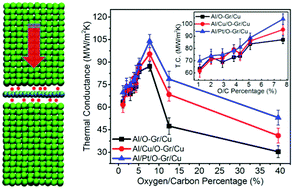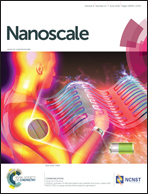Covalent bonding modulated graphene–metal interfacial thermal transport†
Abstract
We report the covalent bonding enabled modulation of the interfacial thermal conductance between graphene and metals Cu, Al, and Pt by controlling the oxidation of graphene. By combining comprehensive X-ray photoelectron spectroscopy (XPS) analysis and time-domain thermoreflectance measurements, we quantify the effect of graphene oxidation on interfacial thermal conductance. It was found that thermal conductance increases with the degree of graphene oxidation until a peak value is obtained at an oxygen/carbon atom percentage of ∼7.7%. The maximum enhancement in thermal conductance was measured to be 55%, 38%, and 49% for interfaces between oxidized graphene and Cu, Al, and Pt, respectively. In situ XPS measurements show that oxygen covalently binds to Cu and graphene simultaneously, forming a highly efficient bridge to enhance the thermal transport. Our molecular dynamics simulations verify that strong interfacial covalent bonds are the key to the thermal conductance enhancement. This work provides valuable insights into the mechanism of functionalization-induced thermal conductance enhancement and design guidelines for graphene-based devices.



 Please wait while we load your content...
Please wait while we load your content...